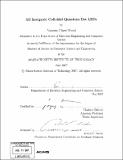All inorganic colloidal quantum dot LEDs
Author(s)
Wood, Vanessa Claire
DownloadFull printable version (11.87Mb)
Alternative title
All inorganic colloidal QD light emitting devices
Other Contributors
Massachusetts Institute of Technology. Dept. of Electrical Engineering and Computer Science.
Advisor
Vladimir Bulović.
Terms of use
Metadata
Show full item recordAbstract
This thesis presents the first colloidal quantum dot light emitting devices (QD-LEDs) with metal oxide charge transport layers. Colloidally synthesized quantum dots (QDs) have shown promise as the active material in optoelectronic devices because of their tunable, narrow band emission. To date, the most efficient QD-LEDs involve a monolayer of closely packed QDs sandwiched between organic charge transport layers. However, these organic materials are subject to degradation due to atmospheric oxygen and water vapor. In contrast, metal-oxide films used in this work are chemically and morphologically stable in air and can withstand numerous organic solvents, which increases the flexibility of device processing. Furthermore, they can sustain higher carrier injection rates needed to realize an electrically pumped colloidal QD laser. This thesis details the characterization techniques, such as Atomic Force Microscopy, photoluminescence spectroscopy, Hall Effect measurements, X-Ray Diffraction, and Ultraviolet Photoelectron Spectroscopy, used to design efficient QD-LEDs. It reviews the steps used to optimize device performance and obtain a transparent device architecture with external quantum efficiency of 0.15% and a peak luminance of 7000 Cd/m2. This manifests a 100-fold improvement in efficiency over any previously reported all inorganic QD-LED structure.
Description
Thesis (S.M.)--Massachusetts Institute of Technology, Dept. of Electrical Engineering and Computer Science, 2007. Includes bibliographical references (p. 85-89).
Date issued
2007Department
Massachusetts Institute of Technology. Department of Electrical Engineering and Computer SciencePublisher
Massachusetts Institute of Technology
Keywords
Electrical Engineering and Computer Science.